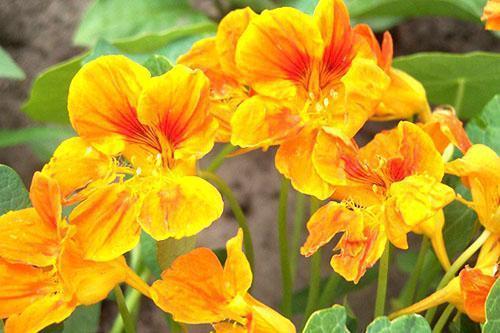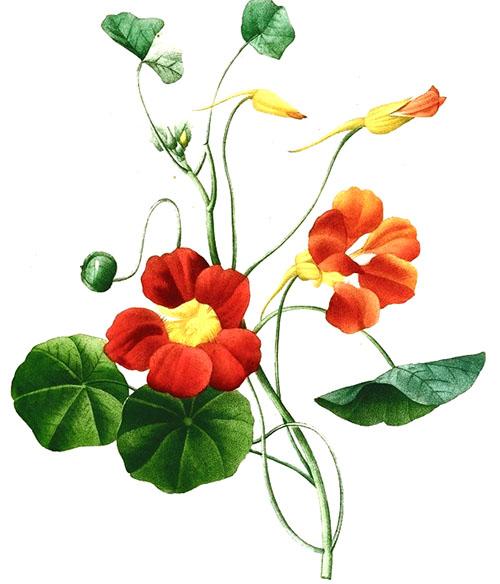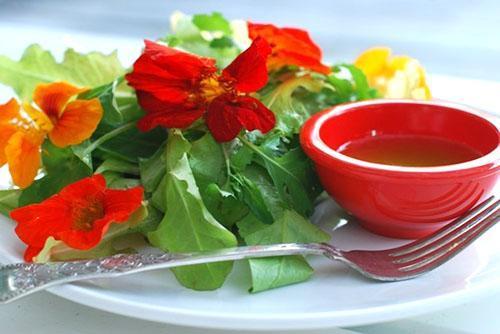Medicinal properties of nasturtium, as well as contraindications
 The extremely beautiful capuchin flower is also a medicinal plant. Its entire aboveground part is useful. Medicinal plants have a special saturation with useful substances during flowering. We understand the medicinal properties of nasturtium and contraindications to its use.
The extremely beautiful capuchin flower is also a medicinal plant. Its entire aboveground part is useful. Medicinal plants have a special saturation with useful substances during flowering. We understand the medicinal properties of nasturtium and contraindications to its use.
The use of nasturtium in traditional medicine

- herbal antibiotics;
- essential oils;
- organic acids.
Flowers contain dyes and carotenoids, vitamin A, just like in carrots. Leaves and stems nasturtium contain a wide variety of bioactive substances, trace elements and rare bioactivators - isoquercitrin and gluconasturcin. The presence of special substances makes infusions and decoctions healing and prophylactic for the body.
 All these components make it possible to talk about the beneficial properties of nasturtium, which has the following actions:
All these components make it possible to talk about the beneficial properties of nasturtium, which has the following actions:
- bactericidal;
- vasodilators;
- anti-inflammatory;
- antitussive;
- antifungal.
First of all, all parts of the plant contain a large amount of ascorbic acid, vitamin C. Therefore, all ailments associated with colds or vitamin deficiency in complex treatment use infusions and decoctions of plant origin. Patients are advised to rinse the throat with a diluted tincture, juice, or decoction. Therefore, the use of vitamin tea with nasturtium will have a beneficial effect on scurvy.
The benefits of using a decoction of nasturtium for colds and coughs can be judged by the presence of antibiotics, which help to restore the mucous membrane of the respiratory system with a deep suffocating cough.
Taking tea with nasturtium can be very useful for the elderly:
- improves the work of the heart muscle;
- slows down premature aging;
- improves the course of menopause.
 Sulfur compounds contained in plant materials relieve sclerosis. Tropeolin, present in the plant, enhances the contraction of the heart muscle. Potassium is essential for heart function. The essential oil slows down the aging process. The diet of older people includes salads and seasonings with the addition of nasturtium as a prevention against senile dementia. Hot flashes during menopause decrease as hormone levels return to normal.
Sulfur compounds contained in plant materials relieve sclerosis. Tropeolin, present in the plant, enhances the contraction of the heart muscle. Potassium is essential for heart function. The essential oil slows down the aging process. The diet of older people includes salads and seasonings with the addition of nasturtium as a prevention against senile dementia. Hot flashes during menopause decrease as hormone levels return to normal.
In folk medicine, nasturtium is used for irritability and depression. With inflammation of the genitourinary system, taking a decoction relieves the patient's condition. Use it for hair loss problems. Together with nettle, rubbing the tincture into the scalp for a week leads to improvement.
 Nasturtium in medicine has already been adopted. The medical industry produces preparations, the active ingredients of which are extracts from nasturtium. They are used as medicines for many diseases. But it should be especially noted that the effect on formidable diseases is confirmed:
Nasturtium in medicine has already been adopted. The medical industry produces preparations, the active ingredients of which are extracts from nasturtium. They are used as medicines for many diseases. But it should be especially noted that the effect on formidable diseases is confirmed:
- tumors;
- coronary insufficiency;
- atherosclerosis.
The effectiveness of the medicinal plant is being studied by scientists all over the world. Maybe in the near future new discoveries await us.
 Like any medicinal plant, nasturtium has contraindications.You cannot start taking the drug without consulting your doctors. In addition to individual intolerance to nasturtium by individuals, uncontrolled consumption of tea or broth in large quantities can also harm. This will cause stomach upset and vomiting. It is forbidden to use any teas or dosage forms if there are diseases of gastritis and stomach ulcers. Using tinctures and rubbing on the skin, you need to protect your eyes, since all nasturtium preparations have a burning effect. The medicinal properties and contraindications of nasturtium, like other herbal preparations, have a blurred border. Therefore, you need to start treatment with caution.
Like any medicinal plant, nasturtium has contraindications.You cannot start taking the drug without consulting your doctors. In addition to individual intolerance to nasturtium by individuals, uncontrolled consumption of tea or broth in large quantities can also harm. This will cause stomach upset and vomiting. It is forbidden to use any teas or dosage forms if there are diseases of gastritis and stomach ulcers. Using tinctures and rubbing on the skin, you need to protect your eyes, since all nasturtium preparations have a burning effect. The medicinal properties and contraindications of nasturtium, like other herbal preparations, have a blurred border. Therefore, you need to start treatment with caution.
Correct procurement of raw materials
 Plants are harvested during the entire flowering period. Flowers are harvested when they have not started to wither. Harvesting should take place in the morning, when the plant has dried out from the morning dew. In this case, the flowers are dried in a dark, well-ventilated area. It is ideal to dry flowers in dry, sunny weather in the attic. If drying takes place in a room, then you need to install a fan to speed up the process. After that, the raw materials are packed in paper bags or boxes.
Plants are harvested during the entire flowering period. Flowers are harvested when they have not started to wither. Harvesting should take place in the morning, when the plant has dried out from the morning dew. In this case, the flowers are dried in a dark, well-ventilated area. It is ideal to dry flowers in dry, sunny weather in the attic. If drying takes place in a room, then you need to install a fan to speed up the process. After that, the raw materials are packed in paper bags or boxes.
 Green fruits are harvested after flowering in about a week. They taste like capers. They can be canned, frozen or dried in the shade. Dried fruits should be peeled and stored in paper bags. The shelf life of plant materials does not exceed 18 months.
Green fruits are harvested after flowering in about a week. They taste like capers. They can be canned, frozen or dried in the shade. Dried fruits should be peeled and stored in paper bags. The shelf life of plant materials does not exceed 18 months.